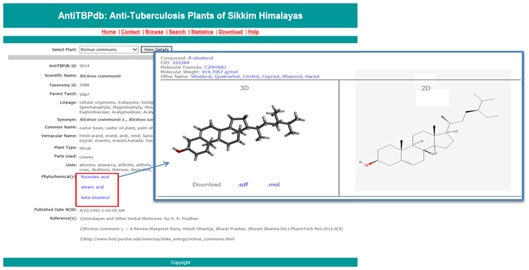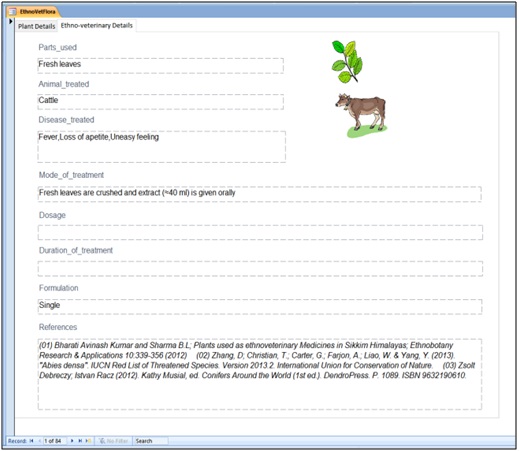
Sunil S. Thorat
Scientist Name: Dr. Sunil S. Thorat
Designation/Position: Scientist-E (Bioinformatics) and Scientist-in-charge, IBSD Mizoram Centre
Department/Programme Name: Bioresources Database and Bioinformatics
Academic Qualifications :
• 2015, Ph.D, Sant Gadge Baba Amravati University, Amravati, Maharashtra, India
• 1999, Advance Diploma in Bioinformatics, University of Pune, Pune, Maharashtra
• 1996-98, M.Sc. Biotechnology, Dept. of Biotech. Amravati University, Amravati (MS)
• 1993-96, B.Sc. Biology, Amravati University, Amravati, Maharashtra
Experience :
• 2015 April – till date, Scientist-E, IBSD, Imphal, Manipur, India
• 2018 June - 2020 June, Senior Scientific Officer, RGSTC, Mumbai, Maharashtra
• 2010 July - 2017 January, Scientist-C & OSD, RCIBSD, Gangtok, Sikkim, India
• 2005 April - 2010 April, Scientist-B, IBSD, Imphal, Manipur, India
• 2003 September - 2005 April, Scientist-B (Contract), IBSD, Imphal, Manipur, India
Awards & Fellowships :
|
Name of Honor/Award |
Awarding Agency/ Institute |
Year |
|
DBT-Merit Fellowship: During Advance Diploma in Bioinformatics at Bioinformatics Centre, University of Pune, Pune, Maharashtra, India |
Department of Biotechnology, Govt. of India |
1999 |
|
DBT’s Travel grant Award for attending 6th International Confrence on Bioinformatics (InConB) during 2006 at HKUST, HongKong. |
Department of Biotechnology, Govt. of India |
2006 |
Memberships (Professional Associations / Societies)
• Life member of Association of Biotechnologist
Specialized Training:
(I) Two months visiting fellowship program on “ Microbial Diversity Analysis and Characterization of antimicrobial encoding genes from microbial origin ” from 1st Feb to 30th March, 2009 in MKU, Madurai, Tamil Nadu
(II) Training workshop on “ Integrating IPR culture with R & D “. & Regional Seminar on “ Energy Scenario of Patent protection, Valuation & Commercialization ” from 15th to 16th Feb., 2006.
Research Theme Photo:

DATABASE AND DOCUMENTATION
• Development of digital database on medicinal plants of North East India – with special reference to Manipur, Sikkim, Me
• Comprehensive documentation on Antiviral plants of North East India
• Digital Database development on Orchids of North East India
• Geo-reference database on Edible Insect resources of North Eastern Region of India.
• Documentation of Insecticidal Plants of North East India
• Documentation of the Microbial Resources of North East India
• Preparation of documentary on Traditional Foods of North East India.

Documentation of bioresources of North East Region and studies using bioinformatics approaches
1. Rhododendron of Sikkim Himalayas (45 records)

Screenshot of inhouse database of Rhododendrons of Sikkim Himalaya
2. Tradable Bioresources (Plant) of Sikkim (survey & analysis)
3. Ethno pharmacological plants of Sikkim Himalayas (122 records)
4. Ethno Veterinary Plants of Sikkim Himalayas (85 records)
5. AntiTBPdb: A database of Anti-Tuberculosis phytochemicals from Sikkim Himalayan plants (16 plant species, 64 phytochemical records)

Screenshot of AntiTBP Database of Sikkim Himalaya
|
|
|
6. Verticals involved
Phytopharmaceutical Mission, Ethnobotany, Ethnopharmacology & Drug Discovery for documentation and bioinformatics research.
7. Research Area/Research Expertise
Bioresources Database Development, Biodiversity Informatics studies, Next Generation Sequencing (NGS) Data analysis. Molecular Dynamics and Phylogenetic Analysis.
8. Research Summary
Software/Applications Developed: Simple Sequence Repeats (SSR) software developed to find out the combination of Di, Tri, Tetra, Penta and Hexanucleotide repeatsfrom the given sequence as a result along with tabular and graphical descriptions.
Re-Digester– Restriction Digestion Software is developed to locate, fragment and calculate the size of agiven sequences to find out the number of fragments, its location sites and sizes.
Bioinformatics: In silico phytochemical drug-likelihood analysis of Swertia chirayita was done for molecular mechanism of action of these plant derived molecular entities (PDME)-amarogentin for its inhibitory action on human cyclooxygenases-2 (COX-2). A novel approach was made to find the selectivity of the ligand for the induced isoform of cyclooxygenases (COX), it was found that; amarogentin is not only selective in its activity butits activity is comparable to that of existing FDA approved leads for inhibiting the COX-2.Intra-specific genetic diversity, phytochemical analysis and antioxidant activities of a potential Himalayan Swertia (Swertia bimaculata Hook. F. & Thomas.) was performed with the Plant Biotechnology Lab.
PUBLICATIONS:
Articles in Journals:
1. Chaudhary SK, Kharlyngdoh E, Shukla JK, Bhardwaj PK, Thorat SS , Bhowmick S, Sharma N, Mukherjee PK. Antidiabetic and Antioxidant activities of Indian Bay Leaf (Cinnamomum tamala (Buch.-Ham.) T. Nees & Eberm.) Essential Oils Collected from Meghalaya. (2024). Chem Biodivers .e202400879. doi: 10.1002/cbdv.202400879.
2. Shukla JK, Basor K, Dhakal P, Thapa S, Kharlyngdoh E, Thorat SS , Bhardwaj P, Chaudhary SK, Mukherjee PK. (2024). Chrono-spatial reproductive phenology of Swertia bimaculata Hook.f. & Thomson ex C.B.Clarke reveals suitability as climate-changing bio-indicator along the Sikkim Himalayan altitude, Heliyon. 10(15), e35275, https://doi.org/10.1016/j.heliyon.2024.e35275.
3. Jitendra Kumar Shukla, Preeti Dhakal, Sandhya Thapa, Evanylla Kharlyngdoh, Sunil S. Thorat , Pardeep K. Bhardwaj, Sushil K. Chaudhary, N. Sathyanarayan, Vinod Singh Gour, Pulok K. Mukherjee. (2023). Growth, yield and metabolite substantiated, eco-physiological evaluation of overcoming accessional and agro-climatic differences in ex-situ raised Valeriana jatamansi Jones. at lower altitude of Sikkim Himalayan region. Indust. Crops.Prod. 207: https://doi.org/10.1016/j.indcrop.2023.117730.
4. Sunil S. Thorat . (2022). Community Based Integrated Livelihood Approach for Sustainable Development. Biodiversity Online Journal . 2(1):1-3.
5. Moirangthem Lakshmipriyari Devi, Sunil S. Thorat , Khomdram Khedashwori Devi, Kongbrailatpam Chandradev Sharma, Yumnam Dhaneshwor Singh, Amrita Mishra, Sudripta Das. (2022). Internal Transcribed Spacer (ITS) Region of Nuclear Ribosomal DNA as a Suitable DNA Barcode for Identification of Zanthoxylum armatum DC. from Manipur. Mol Biotechnol 64, 1454–1467 (2022). https://doi.org/10.1007/s12033-022-00518-9.
6. Madhusmita Mahapatra, Bhumika Gurung, Bharat Gopalrao Somkuwar, Sunil S Thorat , Bikash Rai, Pravin Kumar, & Lokesh Deb. (2021). Perspectives of traditional health care system of Sikkim, North-East India – An ethno-pharmacological survey and analysis. Indian Journal of Traditional Knowledge. 20(4):965-981.
7. Madhusmita Mahapatra, Sunil S. Thorat and Lokesh Deb. (2020). Tradable Plant Species of Sikkim Himalayas. International Journal of Biomedical and Advance Research . ISSN: 2229-3809 (Online); 2455-0558. DOI: https://doi.org/10.7439/ijbar. e-5563.
8. Sanjeet Kumar, Sunil S Thorat , Gopinath Mondal, PD Singh, RK Labala, LA Singh, BG Somkuwar, B Thongam. (2019). Morphological characterization and ecology of Utricularia aurea Lour. Advances in Plants & Agriculture Research . 9(1):61?63.
-
Bharat G. Somkuwar L. Amitkumar Singh &
Sunil S. Thorat
. (2018). Record
shot of Black Eagle Ictinaetus malaiensis (Temminck, 1822) at Kamjong,
Indo-Burma region.
Journal of
Biodiversity and Conservation.
1(2):57-59.
-
Th.
Surbala Devi, P.D. Singh, B.G. Somkuwar,
S.S. Thorat
and S. Kumar. (2018). Oberonia pachyrhachis
(Orchidaceae): a new addition to the flora of Manipur, India.
Jardin Botanique de Guyane -
Richardiana
. Vol-2. pp.1-7.
-
Sunil. S. Thorat
, P. Mahanti and S. Kumar. (2018).
Food habit of Oriental White Eye Zosterops palpebrosus (Temminck, 1824) at
urban areas of Imphal, Manipur.
Journal
of Biodiversity and Conservation.
JBC-APRF-2(1):111-111.
-
Sanjeet
Kumar, Puyam Devananda Singh, Huidrom Sunitibala Devi, Biseshwori Thongam,
Bharat Gopalrao Somkuwar and
Sunil
Shriram Thorat
. (2018). Cymbidium dayanum and Cymbidium sinense
(Orchidaceae): two new additions to the orchid wealth of Manipur, India.
Jardin Botanique de Guyane -
Richardiana
. Vol-2. pp.82-87.
-
Sanjeet
Kumar and
Sunil S Thorat
.
(2018). Aeschynomene manipurensis: A New Species from Indo-Burma
Biodiversity Hotspots.
Species
,
19, 23-25.
-
Sanjeet
Kumar and
Sunil S Thorat.
(2018). Addition of a host plant of an epiphytic orchid species (Vanda
testacea (Lindl.) Rchb.f.) from Indo Burma Biodiversity Hotspot, India.
Journal of Biodiversity and
Conservation.
JBC-APRF-2(1): 108-108.
-
Padma
Mahanti,
Sunil S. Thorat
,
Sanjeet Kumar. (2017). Phenology and key characters for the restoration of
Hypericum gaitii Haines: a threatened plant species of Similipal Biosphere
Reserve, Odisha, India.
Journal of
Biodiversity and Conservation
. JBC-APRF-1(2):34-34.
-
Zeeshan
Ahmad Khan, Rajendra Kumar Labala, Gopinath Mondal, Haobijam Sanjita Devi,
Chongtham Rajiv, Thangal Yumnamcha, Sijagurumayum Dharmajyoti Devi,
Rupjyoti Bharali,
Sunil S Thorat
and Asamanja Chattoraj. (2016). The daily expression profile of Neuropeptides
(gnih, gnrh3, kiss1 and kiss2): A study of possible interaction in the
brain of Zebrafish (Danio rerio).
Journal
of Endocrinology and Reproduction
, Vol 20(1), 129-138. DOI:
10.18311/jer/2016/15662 ISSN (Online): 2250-1460.
-
Shantanu
Shukla, Khushboo Bafna, Durai Sundar,
Sunil
S. Thorat
. (2015). The Bitter Barricading of Prostaglandin
Biosynthesis Pathway: Understanding the Molecular Mechanism of Selective
Cyclooxygenase-2 Inhibition by Amarogentin, a Secoiridoid Glycoside from
Swertia chirayita.
PLoS ONE
9(3): e90637. doi:10.1371/journal.pone.0090637.
-
Intra-specific
genetic diversity, phytochemical analysis and antioxidant activities of a potential
Himalayan Swertia (Swertia bimaculata Hook. F. & Thomas.) (2013),
Jayashankar Das, Sandhya Thapa, Deepti Pradhan,
Sunil S. Thorat
, Narayan C. Talukdar,
Indust. Crops. Prod.
49: 341-347.
-
Analysis of Staphylococcus using
comparative genomics.
Sunil S. Thorat
and Prashant V. Thakare.
(2013).
International Journal of
Scientific & Engineering Research
, Volume 4, Issue 11,
November-2013. ISSN 2229-5518.
-
Comparison of simple sequence
repeats in Staphylococcus strains using in-silico approach (2012),
Thorat
Sunil
and Thakare Prashant,
Bioinformation.
8(24). p. 1182-86.
-
A database on parasitoid of
insect pests of crops in Manipur, India. (2010), S. Subharani,
S. S.
Thorat
, N. Abem, L. Amit Kumar and T. K. Singh.,
The Journal of
Plant Protection Sciences.
2(2). p.10-16.
-
Phylogenetic analysis based on chloroplast
matK
gene
to establish the relationship amongst family
Zingiberaceae
found in
Manipur, India. (2012).
Thorat S.S
. and Chongtham S.
Int. Jr. of
Novel Trends in Pharma Science
. 2(5). p. 174-176.
-
Natural resources conservation at grass root level - A study
among the selected school children of Manipur (India) towards biodiversity
conservation and its sustainable conservation. (2012). Rajiv Das Kangabam,
S. S. Thorat
and Medhabati Kangabam.
NeBio
. 3(3). ISSN
0976-3597.
-
Application of computer for taxonomical classification of
Myxomycetes, (2004).
Sunil S. Thorat.
Bioinformatics India
,
pp 11-16.
Chapters in Books :
1. Chanda, C., Kumar, S., Sherpa, M.T., Thorat, S.S., Das, S. (2024). In-silico Investigations on Exploring Various Aspects of Biorefinery: A Futuristic Paradigm Through Microbiological Perspectives. In: Agrawal, K., Verma, P. (eds) Biotechnological Advances in Biorefinery. Interdisciplinary Biotechnological Advances. Springer, Singapore. https://doi.org/10.1007/978-981-97-5544-8_14
2. Kumar S., Thorat S.S ., Labala R.K., Patra J.K. (2018) Insectivorous Plants of India: Sources of Bioactive Compounds to Fight Against Antimicrobial Resistance. In: Patra J., Das G., Shin HS. (eds) Microbial Biotechnology. Springer, Singapore. https://doi.org/10.1007/978-981-10-7140-9_14
3. Sanjeet Kumar, P. Devanda Singh, Rajendra K. Labala, Amitkumar Singh and Sunil S. Thorat . (2017). Medicinal Plant Diversity in Urban Areas. Ethnopharmacology and Biodiversity of Medicinal Plants (1st ed.). Chapter-5. Apple Academic Press. Taylor & Francis Group. https://doi.org/10.1201/9780429398193105-116.
4. Sunil S. Thorat , Jayashankar Das, Jitendra Shukla, Shantanu Shukla. (2015). Swertia chirayita: Revisiting the potential bioresource and therapeutic applications. Ed. A. Barua. Medicinal and Aromatic Plants: Exploration and Utilization . pp. 125-143
5. Jayashankar Das, Sandhya Thapa, Sunil S. Thorat . (2015). Indian Valerian: A high valued medicinal crop with immense therapeutic potential. Ed. A. Barua. Medicinal and Aromatic Plants: Exploration and Utilization . pp.104-114
6. Somkuwar B.G. Thorat S.S. Subharani S. Abem N. and Hore D.K. (2011). Status and Conservation of Bio-Diversity in North East India. on Biodiversity of Bamboo: Aspect and Prospect in North-East India ’ Chapter 12. Edited by M.D. Choudhary et.al .
Other Publications:
1. Sunil S. Thorat (2012): Bridging research to extension: Strategies and Policies – Role of RCIBSD, Souvenir of Bridging research to extension: strategies and policies, ICAR Complex for NEH Region, Tadong, Sikkim.
2. Sunil S. Thorat (2009): Biodiversity Informatics: An emerging area in Bioinformatics, Compendium of National Seminar on Application of Bioinformatics in Biodiversity, S. Kula Women’s College, Nambol, Manipur.
3. Sunil S. Thorat (2009): Opportunities for Biotech students in Bioinformatics, The Souvenir for AMBAA-Meet - 2009, SGB Amravati University, Amravati (Maharashtra).
4. Sunil S. Thorat (2008): Bioinformatics for microbial genomics, Proceedings of the workshop cum training programme on Recent advances in Microbial Biotechnology & Molecular Biology, North Eastern Regional Institute of Science and Technology, Nirjuli, Arunachal Pradesh, pp 161-166.
5. Sunil S. Thorat , (2008): Advances in Microbial Bioinformatics, Proceedings on Recent advances in Microbial Biotechnology & molecular Biology , Dept. of Forestry, NERIST, Nirjuli, Itanagar. 167-168.
6. Sunil S. Thorat (2005): Biodiversity database for conservation of plants and animals, Souvenir and abstracts on National Symposium on Biodiversity, Conservation & Sustainable Utilization of Bio-Resources, Department of Botany, Iswar Saran Degree College, Allahabad Unversity, Allahabad. Pp. 115.
7. Chanda, C., Kumar, S., Sherpa, M.T., Thorat, S.S ., Das, S. (2024). In-silico Investigations on Exploring Various Aspects of Biorefinery: A Futuristic Paradigm Through Microbiological Perspectives. In: Agrawal, K., Verma, P. (eds) Biotechnological Advances in Biorefinery. Interdisciplinary Biotechnological Advances. Springer, Singapore. https://doi.org/10.1007/978-981-97-5544-8_14
International Conference (Poster Presentation):
Sunil. S. Thorat , Nilima Huidrom and Rajiv Das Kangabam. (2007): Ethnobotanical plant database of NE India., Proceedings of Incob2007, HKUST, Hong Kong.
Poster Presentations:
1. Sunil S. Thorat , (2005): Biodiversity database for conservation or plant and animals, National Symposium on Biodiversity, Conservation and Sustainable utilization of bioresources, Dept. of Botany, University of Allahabad.
2. Sunil. S. Thorat , Nilima Huidrom and Rajiv Das Kangabam. (2007): Ethnobotanical plant database of NE India., Proceedings of Incob2007, HKUST, Hong Kong.
3. Sunil S. Thorat . (2011). ‘Ethnobotanical database of Family Zingiberaceae found in Manipur’. National Seminar on ‘Biodiversity Conservation and Climate change (BCCC-11)’ at IMMT CSIR, Bhubaneswar, Orissa.
4. Sunil S. Thorat . (2012). ‘Comparison of simple sequence repeats in Staphylococcus strains using in-silico approach’ National Seminar on Intelligent Computing in Biological Sciences (ICIBS 2012), Navi Mumbai.
5. Sunil S. Thorat . (2014). ‘Diversity Studies Of Staphylococcus Strains Using Comparative Genomics Approach'. International Symposium on Genetic Analysis: translational and Developmental at Dept of Zoology, University of Burdwan.
6. Sunil S. Thorat . (2016). 'Database on Ethno pharmacological Plants of Sikkim Himalayas' at 3rd International Congress of Society of Ethnopharmacology, India at Pt. Ravishankar Shukla University, Raipur.
7. Sunil S. Thorat . (2015). 1st National Bioresources and Sustainable Development Summit -2015 at IBSD, Imphal
8. Sunil S. Thorat. (2015). ‘Anti-cancerous photochemical database of Sikkim, India: a computational approach for understanding Cancer’ at Indo-Japan Symposium on Advances in Biomedicine and Bioinformatics, Indian Institute of Technology (IIT), Delhi.
Oral Presentations:
1. Sunil S. Thorat , (2000): presented a research paper in the National Conference in Recent trends in Biotechnology at Amravati University, Amravati on 3-5th February, 2000.
2. Sunil S. Thorat , (2013): presented research paper in the National Conference on Comtemporary Bioinformatics Researchers in India, organized by Bioinformatics Centre, Assam University, Silchar on 10th November 2013.
Invited Lectures:
1. Sunil S. Thorat , (2008): given lecture on 'Recent Advances in microbial Biotechnology & molecular Biology' from 6-10th October 2008 at NERIST, Nirjuli, Arunachal Pradesh.
2. Sunil S. Thorat , (2008): given lecture on 'Recent Advances in microbial Biotechnology & molecular Biology' from 6-10th October 2008 at NERIST, Nirjuli, Arunachal Pradesh.
3. Sunil S. Thorat , (2019): Delivered a presentation at Summer Research Aptitude Cultivation Workshop at KBC North Maharashtra University, Jalgaon on 8 th June 2019.
4. Sunil S. Thorat , (2019): Delivered a presentation at DST Inspire Internship Science Camp at Shri Shivaji Science College, Amravati during 28 th December, 2019.
5. Sunil S. Thorat. (2023): Delivered a lecture on Emerging trends of Artificial Intelligence in Biology at Saint Edmonds College, Shillong Meghalaya, 11 th July 2023.
Other Achievements:
Completed online certificate course on Google AI Essentials by coursera, October 2024
A. Extramural Projects as Coordinator:
|
Sl No. |
Title of Project |
Funding Agency |
Date of completion |
|
1. |
Distributed Information Sub Centre (DISC) |
DBT, GoI |
31-03-2020 |
|
2. |
Regional Resource Agency for establishment of DNA Clubs |
DBT, GoI |
30-09-2010 |
|
3. |
Orchid bioresources of the North-east India – Conservation, database development and information networking |
DBT, GoI |
31-03-2019 |
Major facilities created:
Established Regional Centre of IBSD (RCIBSD) at Sikkim as OSD during 2010-2017:
Facilities created at Regional Centre of IBSD (RCIBSD), Sikkim:-
Three laboratories namely Plant Bioresources, Microbial Resources and Bioinformatics & Documentation at Tadong, Gangtok.
Created Plant Nursery for keeping collected plants and other field works at Tadong, Gangtok.
Created Green house, Shade house & field laboratory at Marchak, Sikkim.
Built Tarpaulin based water harvesting tank for watering field plants.
Administrative Work: Looked after the day to day institutional administrative & accountancy activities as Officer on Special Duty which includes official communications with the headquarter at Imphal and interactions with State and National Institutes in Sikkim for institutional activities including meetings and official procedures.


